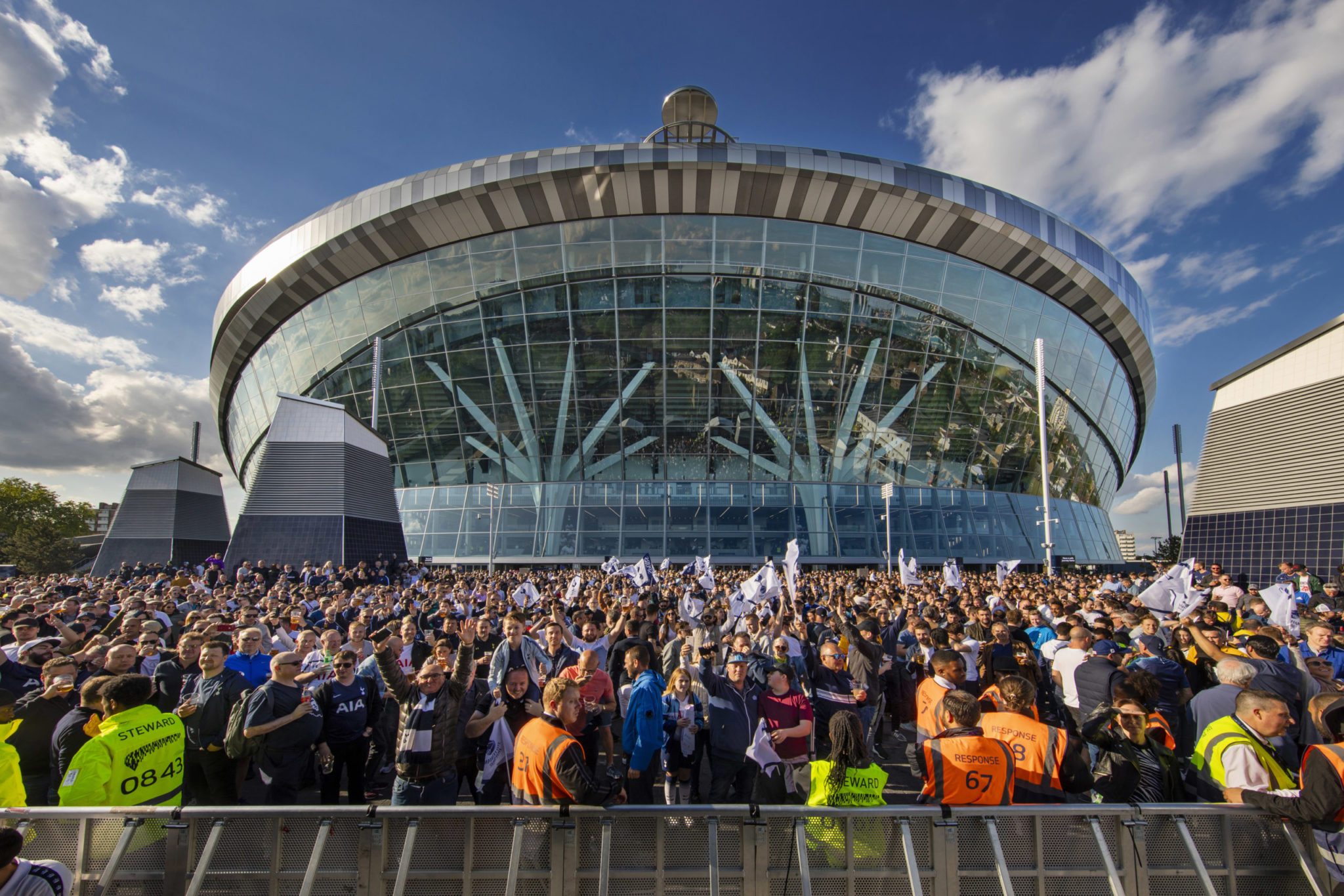Leveraging Technology to Revolutionize Fan Engagement in Sports & Entertainment
Back in the day, being a sports fan looked differently than it does now. People would gather around radios and televisions at designated times in set locations, pausing the rest of their day to watch their team duke it out on the court with a rival.
Today, technology is dramatically altering how fans engage with sports. Social media has essentially made the sports bar ubiquitous, allowing fans to watch livestreams of sporting events from anywhere while chatting with friends across the globe. It’s also elevated athletes to true celebrity status–Lebron James currently clocks in at just under 160 million followers on Instagram. In short, stadium and arena technology solutions have completely changed the way we interact with sports: as players, as fans, as consumers of entertainment. There’s a new immediacy and a greater cohesion between the various spheres of our lives now thanks to the digital connectivity that powers so many of our interactions on a daily basis.
And our love for big-time sporting events hasn’t waned. People still love the stadium experience, with the NFL reporting that 2023 saw the highest live game attendance since 2015, with total tickets sold equaling 18.9 million.
The stadium game experience still shines. But in keeping with the zeitgeist, it’s shining differently thanks to technology. Now the game isn’t just about the game itself: it’s about how the fans experience it, too.

Meeting fans where they're at (but not leaving them there): How digital marketing is supporting an immersive game-day experience
Picture it: it’s gameday, and your rideshare has just dropped you and your friends off at the stadium. As soon as you step out of the car, the stadium experience morphs into a digitally infused adventure. Interactive selfie stations, designed to capture the essence of a particular city or team allegiance, greet you as you step onto the concourse. You and your friends snap pictures and share them on social media, instantly becoming part of the event's narrative. In some stadiums, these selfies can be showcased on massive screens throughout the venue, signaling to everyone present that your excitement and your presence as a fan is essential to the spirit of the game.
This instant engagement and recognition enhance the excitement and sense of belonging among fans, and it’s becoming more and more common as part of the digital immersion experience at live gaming events. Instead of mobile devices being interruptions in an otherwise singular experience, fans can now utilize their devices as integral to the experience, enhancing their connection to the event and their fellow attendees. This digital engagement begins even before entering the stadium, with geo-targeted notifications and exclusive content delivered directly to their phones and drumming up excitement for the event ahead.
Beyond the selfie stations, several other new methods of digital engagement have emerged in modern stadiums. CRI works to enhance the fan experience based on venue itself, and we may choose to bring in a specialty agency with a laser focus on fan engagement. One partner for instance, showcased a stunning example at a predominant NHL Arena with 3D mapping technology that captured fan images and broadcasted them throughout the concourse, creating a visually striking experience that heightened the communal element of game-day excitement. Another, known for their engagement with the team, leverages time with the players to capture content on media day that can be repurposed throughout the season in unique ways.
Other technological advancements that engage with users at the level of their mobile devices include AR (augmented reality) enhancements that provide insights on everything from breakdown of plays, player statistics, and recommendations that cater to an individual’s preferences.
Integration from end-to-end so that you’ll never miss a moment of action
The advent of advanced digital signage and data integration technologies has dramatically transformed the stadium experience beyond just mobile devices. A significant shift began about five years ago when larger venues started making data-driven decisions and integrations a core part of their operations. Previously, digital signage displayed a single, uniform channel across all screens, regardless of location or audience; everyone got the same message from the same screens. Today, each screen can be individually programmed to show content tailored to the specific demographic it serves. For instance, a luxury suite hosting corporate executives can display premium service advertisements and exclusive event information, while general admission areas could focus on fan engagement and social media highlights. This precision targeting not only enhances the fan experience by providing relevant and engaging content but also increases the value of each display in terms of revenue generation. Leveraging data in this manner allows venues to maximize the impact of their digital signage networks, making each screen a strategic asset and sales tool, rather than a mere display.
Integrating digital signage with point-of-sale (POS) systems at food and beverage counters, and even in-venue retail shops, is another innovation that’s enhancing the fan experience in stadium settings. This integration allows for dynamic digital menu board solutions that adjust based on real-time factors such as game type, time of day, and audience demographics. Menus might feature premium pricing and exclusive items during prime-time games or rivalry matchups, while offering more family-friendly options and discounts during afternoon events. This flexibility drives sales by appealing to the specific audience present but also optimizes inventory management and profit margins. The ability to tailor offerings to the context of the event—be it a professional game, a college match, or a concert—ensures that fans are presented with relevant choices that improve their overall venue experience. Following the data (and allowing it to inform marketing strategies) in this way extends understanding which products are most popular among different demographics, allowing venues to strategically place the most relevant items in prime locations, maximizing sales and satisfaction at the same time.
Another huge advancement that’s revolutionizing fan engagement in sports entertainment is the integration of IPTV (Internet Protocol Television) systems within stadiums. These systems enhance live streaming and in-venue broadcasts and keep fans connected to the action no matter where they’re at within the venue. Whether they’re in line for concessions, taking a break in the lounge, or navigating crowds on the way to the restroom, screens positioned throughout the stadium broadcast live game footage, replays, and tailored content and keep fans engaged and informed.
These screens can also display targeted advertisements and promotions, such as limited-time offers at nearby concession stands; or switch to live footage to minimize the feeling of missing out for fans waiting in line. This helps create a seamless blend of entertainment and marketing that keeps fans engaged while driving additional revenue.
What is looks like on the backend: Mastering implementation and ROI with strong partnerships
Behind the scenes, the seamless fan experiences created by digital innovations in stadiums require a sophisticated and well-coordinated backend system. These systems integrate various aspects of the stadium experience, from food and beverage to IPTV (live streaming) and social media. Successful implementation of these elements relies on solid strategic partnerships with technology providers, content creators, and third-party agencies that specialize in maximizing different facets of the fan experience.
For instance, collaborations with POS system vendors enable real-time menu updates and dynamic pricing, while partnerships with marketing agencies help tailor sponsorship assets to specific audience segments, boosting revenue potential. Consolidation of these technologies into a unified platform ensures that all elements work together seamlessly, delivering a cohesive experience to fans. This integration helps venues efficiently manage content across multiple screens, dynamically adjust offerings, and capture valuable data to continuously refine and improve the fan experience.
When it comes to measuring ROI, A/B testing is often used, comparing performance from different seasons or sections with and without digital displays. For example, digital signage might be installed in the north end while the south end remains static. Point-of-sale data from both areas is then analyzed, focusing on similar demographics; this allows the impact on sales to be clearly identifiable. If digitally advertised items show a sales boost compared to static ones, the signage is deemed effective.
Relatedly, sponsorship and partnership opportunities also help offset initial investments. Placing ads in restrooms through agencies that install infrastructure for free in exchange for revenue sharing helps stadiums generate significant new revenue. In MLS stadiums, such initiatives have brought in hundreds of thousands of dollars per season, recouping the digital signage investment within a few years. This blend of data analysis and strategic partnerships is one way to ensure digital signage for stadiums and arenas delivers financial returns.

What's ahead? Taking personalization to the max
The next wave of technological advancements in stadiums promises even more personalized and immersive experiences for fans. One exciting development is the personalization of content delivered to individual phones. Imagine receiving tailored notifications, exclusive offers, and real-time game insights directly to your device, all based on your preferences and behaviors. This level of personalization, though still in development, will further enhance the fan experience by making it more interactive and engaging than ever before. AI and machine learning algorithms will play a part in analyzing fan data to deliver highly targeted content, ensuring that every interaction feels uniquely relevant.
The future of stadium experiences will likely see even greater integration of various digital technologies to create a seamless, unified ecosystem. From augmented reality (AR) enhancements that bring game stats to life to advanced analytics that optimize everything from concession sales to crowd management, the focus will continue to be on delivering a holistic experience that caters to fans' every need and fosters an immersive experience.
Things have changed a great deal in sports entertainment, but one thing remains the same: love of the game. Today’s technology is making it easier for fans to engage with one of their greatest passions in new and exciting ways, bringing them closer to the action and creating unforgettable experiences both inside and outside the stadium.
For a closer look at our work across the Stadium and Arena space, tap here to explore our use cases as well as our full digital signage offering and tech stack specific to S&E.
Share this
You May Also Like
These Related Stories

Score Big: Unleashing the Branding Power of Digital Signage in Sports Arenas

Turn Every Fan Moment into Revenue: The Power of Real-Time Digital Activations


